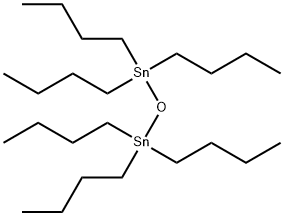Butyltin trichloride
Synonym(s):Butyltrichlorotin
- CAS NO.:1118-46-3
- Empirical Formula: C4H9Cl3Sn
- Molecular Weight: 282.18
- MDL number: MFCD00000515
- EINECS: 214-263-6
- SAFETY DATA SHEET (SDS)
- Update Date: 2025-01-27 09:38:02

What is Butyltin trichloride?
Chemical properties
Clear yellow liquid
The Uses of Butyltin trichloride
Glass hot end spraying
Hazard
Moderately toxic by ingestion. A severe skin and eye irritant.
Flammability and Explosibility
Not classified
Safety Profile
Moderately toxic by ingestion. A severe sktn and eye irritant. Mutation data reported, See also TIN COMPOUNDS. When heated to decomposition it emits toxic fumes of Cl-.
Properties of Butyltin trichloride
| Melting point: | -63°C |
| Boiling point: | 93 °C/10 mmHg (lit.) |
| Density | 1.693 g/mL at 25 °C (lit.) |
| vapor pressure | 11.1Pa at 20℃ |
| refractive index | n |
| Flash point: | 178 °F |
| solubility | 1000g/L in organic solvents at 20 ℃ |
| form | liquid |
| color | colorless to yellow |
| Specific Gravity | 1.693 |
| Water Solubility | SOLUBLE |
| Sensitive | Moisture Sensitive |
| Hydrolytic Sensitivity | 7: reacts slowly with moisture/water |
| Exposure limits | ACGIH: TWA 0.1 mg/m3; STEL 0.2 mg/m3 (Skin) NIOSH: IDLH 25 mg/m3; TWA 0.1 mg/m3 |
| Stability: | Hygroscopic, Moisture Sensitive |
| CAS DataBase Reference | 1118-46-3(CAS DataBase Reference) |
| NIST Chemistry Reference | n-Butyltin trichloride(1118-46-3) |
| EPA Substance Registry System | Butyltin trichloride (1118-46-3) |
Safety information for Butyltin trichloride
| Signal word | Danger |
| Pictogram(s) |
 Corrosion Corrosives GHS05  Exclamation Mark Irritant GHS07  Environment GHS09 |
| GHS Hazard Statements |
H314:Skin corrosion/irritation H335:Specific target organ toxicity, single exposure;Respiratory tract irritation H410:Hazardous to the aquatic environment, long-term hazard |
| Precautionary Statement Codes |
P261:Avoid breathing dust/fume/gas/mist/vapours/spray. P271:Use only outdoors or in a well-ventilated area. P273:Avoid release to the environment. P280:Wear protective gloves/protective clothing/eye protection/face protection. P303+P361+P353:IF ON SKIN (or hair): Remove/Take off Immediately all contaminated clothing. Rinse SKIN with water/shower. P305+P351+P338:IF IN EYES: Rinse cautiously with water for several minutes. Remove contact lenses, if present and easy to do. Continuerinsing. |
Computed Descriptors for Butyltin trichloride
| InChIKey | YMLFYGFCXGNERH-UHFFFAOYSA-K |
New Products
3-Iodophenylacetic acid 3-Pyridineacetonitrile, α-hydroxy- 2-Propanamine, 1-chloro-, hydrochloride (9CI) 3-(hexyloxy)-4-(pyridin-3-yl)-1,2,5-thiadiazole 2-Hexyn-1-ol Dibenzo-18-crown-6 Nickel(II) perchlorate hexahydrate, 98% 4-Bromophenylacetonitrile, 95% 3-Bromo-4-fluoroaniline, 97% Sodium tetraborate decahydrate, 98% Palladium(II) acetate, trimer, Pd 99% 4-Bromo-2-chlorotoluene, 97% N N Dimethylformamide Dimethyl Acetal (Dmf Dma) 2,3-Dichloro Benzoyl Cyanide [Side Chain] Bis(2-Chloroethyl) Amine Hydrochloride L-Glutamic Acid Diethyl Ester Hydrochloride 5-(Difluoromethoxy)-2-Mercaptobenzimidazole 1-Ethyl-3-(3-Dimethylaminopropyl)-Carbodiimide Hydrochloride [EDC Hcl] 1,4-Napthoquinone Bromoiodomethane Sodium Bicarbonate Methylene Dichloride (MDC) Ethyl Acetate Indole-3-Carbinol (I3C)Related products of tetrahydrofuran








You may like
-
 n-Butyltin trichloride CAS 1118-46-3View Details
n-Butyltin trichloride CAS 1118-46-3View Details
1118-46-3 -
 Butyltin Trichloride CAS 1118-46-3View Details
Butyltin Trichloride CAS 1118-46-3View Details
1118-46-3 -
 Butyltin trichloride CAS 1118-46-3View Details
Butyltin trichloride CAS 1118-46-3View Details
1118-46-3 -
 17604-74-9 3-Pyridineacetonitrile, α-hydroxy- 98+View Details
17604-74-9 3-Pyridineacetonitrile, α-hydroxy- 98+View Details
17604-74-9 -
 Cyclohexane, (2-propynyloxy)- 67967-07-1 98+View Details
Cyclohexane, (2-propynyloxy)- 67967-07-1 98+View Details
67967-07-1 -
 2-Propanamine, 1-chloro-, hydrochloride (9CI) 98+View Details
2-Propanamine, 1-chloro-, hydrochloride (9CI) 98+View Details
5968-21-8 -
 3-Iodophenylacetic acid 1878-69-9 98+View Details
3-Iodophenylacetic acid 1878-69-9 98+View Details
1878-69-9 -
 132945-75-6 (S)-1-Boc-3-methanesulfonyloxy-pyrrolidine 98+View Details
132945-75-6 (S)-1-Boc-3-methanesulfonyloxy-pyrrolidine 98+View Details
132945-75-6
Statement: All products displayed on this website are only used for non medical purposes such as industrial applications or scientific research, and cannot be used for clinical diagnosis or treatment of humans or animals. They are not medicinal or edible.
